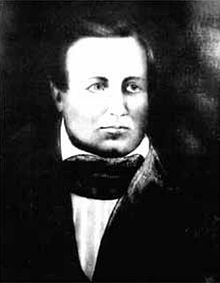Andrew Pickens (governor)
This article includes a list of general references, but it lacks sufficient corresponding inline citations. (March 2013) |
Andrew Pickens | |
|---|---|
 | |
| 46th Governor of South Carolina | |
| In office December 1, 1816 – December 1, 1818 | |
| Lieutenant | John A. Cuthbert |
| Preceded by | David Rogerson Williams |
| Succeeded by | John Geddes |
| Personal details | |
| Born | December 13, 1779 Edgefield County, South Carolina |
| Died | June 24, 1838 (aged 58) Pontotock, Mississippi |
| Political party | Democratic-Republican |
| Spouse(s) | Susan Smith Mary Willing Nelson |
| Alma mater | College of New Jersey |
| Profession | soldier, attorney |
| Military service | |
| Allegiance | United States of America |
| Branch/service | United States Army |
| Rank | lieutenant-colonel |
| Battles/wars | War of 1812 |
Andrew Pickens Jr. (December 13, 1779 – June 24, 1838) was an American soldier and politician. He served as the 46th Governor of South Carolina from 1816 until 1818.
Pickens was the son of well-known American Revolutionary general Andrew Pickens (1739–1817), and Rebecca Floride Pickens (nee Colhoun). He was born on his father's plantation on the Savannah River in Horse Creek Valley in Edgefield County, South Carolina.
He was a maternal cousin of fellow South Carolina politician John C. Calhoun. He was also a paternal cousin of Calhoun's wife Floride.
Pickens attended Brown University, graduating in 1801.[1][2] He served as a lieutenant-colonel in the U.S. Army during the War of 1812. After the war, he established a plantation, "Oatlands", in Edgefield County, and took up the practice of law. He also established a residence, "Halcyon Grove", in the village of Edgefield, and married Susannah Smith Wilkinson.
On December 5, 1816, the South Carolina General Assembly elected Pickens as governor by secret ballot. Pickens championed the construction of roads and canals by government, a policy called internal improvements. During his administration, South Carolina began an internal improvements program. The price of cotton rose to the highest point reached in South Carolina during the antebellum period. The city of Charleston was struck with a disastrous yellow fever epidemic. After leaving office, Pickens moved to Alabama and helped negotiate a treaty with the Creek Indians of Georgia. For a period of time around 1829, he lived in Augusta. Growing up living by Indians, he had a very tight bond with them.
Pickens died June 24, 1838, in Pontotoc, Mississippi, and was interred at Old Stone Church Cemetery in Clemson, South Carolina.[3]
His son, Francis Wilkinson Pickens (1805–1869) was a U.S. Representative and the Governor of South Carolina when the state seceded from the Union in 1860.
External links
- ^ "Pickens, Andrew, Jr". South Carolina Encyclopedia. Retrieved March 12, 2021.
- ^ Greene, Richard Henry (1890). Official Positions Held by Alumni of Yale, Princeton, Columbia, Brown, University of Pennsylvania, and by the Men Educated at William and Mary College: With a Comparative Statement, Including a Resumé from the Material Gathered Concerning Harvard College for the N. E. Hist. and Gen. Register, July, 1887, by Chief Justice Wm. A. Richardson, LL.D., the Papers on Official Positions Held by Alumni of Yale, College of New Jersey, University of Pennsylvania, Columbia College and Brown University. D. Clapp & Son, printers.
- ^ The South Carolina Encyclopedia Guide to the Governors of South Carolina, p. 198
- 1779 births
- 1838 deaths
- United States Army personnel of the War of 1812
- Governors of South Carolina
- People from Edgefield County, South Carolina
- Brown University alumni
- American people of Scotch-Irish descent
- United States Army colonels
- University of South Carolina trustees
- South Carolina Democratic-Republicans
- Democratic-Republican Party state governors of the United States

